Just to make sure I understand where things have progressed so far, most of the Caribbean is British territory, most of North America is part of the US (with the capital at it's rightful place in Philly), and Quebec WAS independent but eventually joins America? Hopefully I'm on the right page with this 
You are using an out of date browser. It may not display this or other websites correctly.
You should upgrade or use an alternative browser.
You should upgrade or use an alternative browser.
Empires of Liberty
- Thread starter JJohnson
- Start date
JJohnson
Banned
More information about the British Empire might be helpful, to gain a better view of events elsewhere around the world, aside from North America.
Printing in the colonies:
Last but not least, let's not forget the colony of British Guyana, which would complete the historians' assessment that the Caribbean was the "British Lake" for much of the 19th century, during "Pax Britannica."
Excerpted from "Colonial Governors of Cuba," (c) 1962:
After Guy Carleton left the post in 1778, the position of colonial governor fell to John Campbell, a rather unremarkable governor regarded by many historian as a placeholder until Sir John Johnson arrived in 1783. This analysis is often overly broad in nature, as Campbell was instrumental in setting regular plans for towns, distributed lands to a number of families in his five years as governor, began a number of public highways, and enabled a number of businesses to grow. For future historian, one of his insightful policies was a decennial census on every year ending in a zero, noting by language and ethnicity the population of the island and city of residence. His numbers for 1740-1770 are estimations, but are generally considered to be more or less accurate.
The fifth governor, Sir John Johnson, 2nd Baronet of New York, brought with him 3800 Loyalists to the Cuba Colony. He settled them in the town he named New Williamsburg (OTL Puerto Padre) on the Williamsburg Bay. Amongst the Loyalists brought with him, Daniel Claus brought 940 to Bay Town (OTL Baracoa), later renamed Charlotte in 1806 in honor of King George III's wife.

Cuban Royal Governor, Sir John Johnson (1783-1796)
King George's policy after the war was to generously reward Loyalist military with land and positions of power in the remaining colonies, to demonstrate his generosity and beneficence. Many of the cities of Cuba today have roots in Loyalist settlers leaving North America, and though there was some agitation in 1842 for independence or self government, the Loyalist sentiment towards the crown earned Cuba the name "The most faithful Island to her Britannic Majesty."
Royal Census of Cuba, First Hundred Years (1740-1840), (c) 2010
By 1842, Cuba's population had reached over 1 million souls:
1740-1 - 6300 British, 43,000 Spanish
1750 - 24,000 British, 19,000 Spanish
1760 - 33,000 British, 11,000 Spanish
1770 - 51,000 British, 11,442 Spanish
1780 - 63,420 British, 11,863 Spanish; non-white: 75,800
1790 - 87,214 British, 6,940 Spanish, 2,100 Quebecois, 1,200 Hessian; non-white: 116,533
-immigration after the American Revolution; emigration to New Spain
1800 - 104,000 British, 4,233 Spanish, 3,600 Quebecois, 1,342 Hessian; non-white: 312,866
-intermarriage between Spanish speakers and British English speakers lead to fewer identifiable Spanish-speakers
-Quebecois includes French speakers fleeing revolutionary France, a distinction that was not made in the historical records
1810 - 191,350 British, 3,104 Spanish, 4,180 Quebecois, 1,622 Hessian; non-white: 385,251
1820 - 267,833 British, 2,518 Spanish, 6,211 Quebecois, 2,412 Hessian; non-white: 418,277
1830 - 396,781 British, 1,304 Spanish, 12,451 Quebecois, 6,922 German; non-white: 492,544
1840 - 469,455 British, 840 Spanish, 18,934 Quebecois, 7,831 German; non-white: 583,442
While a number of the non-white population were slaves held by plantation owners, after the abolition of slavery in the British Empire, a number of freed slaves were 'repatriated' to the freedman's colony of Sierra Leone by a number of members of the Abolition Societies across the Empire, leading to a decline in the number of those counted in 'non-white' until 1900, when more accurate distinctions began to be kept, and immigration from India and China to the Caribbean grew to noticeable numbers.
From British Honduras, the Early Years (2003):
The first true governor was James Robertson, who arrived in 1783, over the desires of the Jamaican governor, who wanted Colonel Edward Marcus Despard in charge of the settlement. Robertson, however, had served as governor of the Province of New York, and also carried with him 5,000 settlers to begin logging and settlement of the area in earnest. He died in 1788, but in his five years, the colony's main settlement at Belize, which he renamed to New South Brunswick, though the reasons why are shrouded in mystery to modern historians. Spurious records have suggested he wanted the colony to feel more 'British' and more like home for the settlers he brought with him, whom he directed at building numerous shelters and homes and businesses.
Robertson's lasting achievement was the Royal Shipyard, which he lobbied for a charter, and turned out its first ship in 1787, the HMS Caledonia, a first-rate ship of the line, with 100 guns, followed soon after by the HMS Hibernia, another first-rate ship of the line, with genuine Honduran wood hull. Both ships would sail the Caribbean, and see action during the Napoleonic Wars and the Invasion of the Rio de la Plata.
After his passing in 1788, the second governor, Andrew Elliot, arrived about the time a number of Newfoundlanders were resettled into the Caribbean, leading to the establishment of the second city, led by John Meyers, a prominent industrialist, who found Newfoundland island poor for resources and business, and desired a new place to settle, refusing to move to Rupert's Land. He settled what was temporarily called Meyer's Creek (OTL Dangriga), later Kingstown (in honor of King George III). He built a gristmill on the river, followed later by a sawmill, distillery, brick kiln, and established a trading post at the edge of town, now part of the old colonial town square. Of the roughly 17,000 Loyalists coming into the Caribbean, 8,000 came to British Honduras, mostly in a continuous fashion, leading Governor Elliot to grant land far inward, to what was unknowingly Spanish-claimed territory at the time, and charter a third settlement, Digby (OTL Corozal), founded by Sir Robert Digby with 1500 United Empire Loyalists.
Elliot's three settlements were far apart, and he commissioned a royal highway be built to link the three in 1789, completed in 1791, which greatly aided communication, commerce, post, and travel times between the settlements. By 1796, Elliot left the governor's post due to health reasons, succeeded by Thomas McKee, the youngest governor the colony would have in its long history. McKee began two more settlements inland, the northern settlement known by natives as Holpatil, colloquially as Sugar Town for the sugar cane the mestizos brought with them there, but called Grimsby (OTL Orange Town) on the 1800 Census of the town (with 800 inhabitants). The southern settlement was named Rawdon, after Francis Rawdon-Hastings, 1st Marquess of Hastings or "Lord Rawdon". It was located on the Sarstoon River. McKee left his post in 1806, when he was replaced by Edward Jessup, a Loyalist soldier from the American Revolution. The total population around this time was about 9,400 white settlers, and about equal numbers of slaves to work their fields. Jessup faced runaway slaves, who escaped into the forests for freedom, along with Mayans in the north, and Spaniards in the frontier. He succesfully lobbied for several divisions of the Royal Army to be stationed inland, which touched off the British Honduras-New Spain War, which lasted from 1805-1808, nearly simultaneously with the Rio de la Plata War (1806-1808), both ended by the Treaty of London (1808).
An invading force from what would become Mexico touched off the war in British Honduras, the end result of which led to the successful annexation of Petén to British Honduras, with a series of forts guarding its borders, manned by permanent garrisons of British soldiers, most of whom served in the war. The population of the colony would grow even further with the shipbuilding, sugar plantations, and early industrialization by entrepreneurs such as Meyers and Howe.
Printing in the colonies:
Kingstown Journal, Histories and Biographies series, "John Howe" by Jeffrey Chan, Kingstown Journal reporter.
John Howe, a loyalist printer who moved to Cuba in 1780, after evacuating from New York, began the Kingsport Journal, whose first issue he printed on December 28, a paper that remained in the family until 1822. One of his apprentices, Edward Harpe, began the British Honduras Journal and Gazette in 1784, a newspaper that continued until 1815, when it folded into the Kingstown Journal, which continues to this day, with a circulation of around 1.9 million issues.
John Howe experienced quite a bit of success in Cuba, when was appointed King's Printer in 1801, responsible for printing the Cuba Royal Gazette and the Debates of the Cuban House of Assembly. In the same year, he was also appointed Postmaster of Kingsport and "agent manager and director of His Majesty's Packet boats in Kingsport," a position that was extended to Deputy Postmaster-General of Cuba, British Honduras, Jamaica, British Guyana, and the Newfoundland Island in 1803. The postmaster positions included expanding and improving delivery routes and establishing way stations as required.
Last but not least, let's not forget the colony of British Guyana, which would complete the historians' assessment that the Caribbean was the "British Lake" for much of the 19th century, during "Pax Britannica."
British Empire, a Brief Overview of the Colonies of the Second British Empire, 2003.
British Guyana, which received 5,000 new settlers in 1815, received a new governor after the Anglo-Dutch Treaty took effect. Most of these settlers came from Cuba and British Honduras (3100), with the rest from the United Kingdom. Georgetown became the capital of the colony, which experienced some growth, but its economy grew slowly until gold and diamond deposits were found, and later bauxite. The colony remained majority African ancestry for most of the 19th century, even after the end of slavery, until around 1870, when bauxite began booming, along with settlers, bringing in over 250,000 settlers from the United Kingdom, Cuba, British South America, and British Honduras, not to mention Americans looking for a better life.
Industry grew in the colony starting in the late 1840s, when William Meyers, one of John Meyers' sons from Cuba, settled there with his wife, Catherine Howe, and their son. They began building up Georgetown's industrial base, which attracted more settlers, including Americans from the north, south, and even Quebecois-Americans, some of whom later resettled in French Guiana. Printing, gristmills, breweries, and factories were built, and afterwards, when diamonds and gold were found, a Royal Mint was created, where Sovereigns and other coins were made for circulation in the British Caribbean colonies.
By 1900, the colony counted over 396,000 settlers, and by 1920 around 622,000. As of 1940, there were around 1.6 million, due to birthrate and immigration.
As the colony expanded, a number of towns grew: New Amsterdam, Summerville (OTL Kamarang), Nieuw Rotterdam (OTL Aishalton), some of which began as border fortifications to secure the British claim to the territory.
(Excerpt from 3 pages ahead):
Today, Nieuw Rotterdam boasts one of the most extensive technology sectors in the country, with over 320,000 people and 20 of the country's 210 millionaires. New Amsterdam, another majority Dutch settlement, boasts a great tourism industry, along with a number of cruise lines. Along with Georgetown, the cities grew to over 300,000 people each, along with a number of over-120,000 towns, bringing the colony to around 3.3 million people. It is not uncommon for tourists from Cuba, Belize, Florida, the Netherlands, and the United Kingdom to be seen in the streets of Georgetown, one of the most popular Caribbean hotspots, with a feel that combined old colonial houses and shopping districts, with modern 50-floor skyscrapers, 1800 ft2 homes, multi-lane highways, high-speed internet, and well ranked private and public schools, contributing to the 99% literacy rate of the country.
JJohnson
Banned
Just to make sure I understand where things have progressed so far, most of the Caribbean is British territory, most of North America is part of the US (with the capital at it's rightful place in Philly), and Quebec WAS independent but eventually joins America? Hopefully I'm on the right page with this
You've pretty much got it right
For Quebec, I didn't want to make it too easy on the United States, so they might be allied now and for a bit, but nothing lasts forever.
JJohnson
Banned
The State of the Empire
Just an overview of the situation as of 1783 (roughly). If anyone wants to map this out, it would be most appreciated.
The American Republic (United States of America) as of 1783:
Massachusetts and the District of Maine
Nova Scotia (OTL Nova Scotia, New Brunswick, Prince Edward Island/St John Island)
Quebec (remainder of territory north of St Lawrence and Great Lakes, and north of New York/Maine/Nova Scotia)
New Hampshire
New York (claims Vermont also)
New Jersey
Delaware
Connecticut
Rhode Island
Pennsylvania
Virginia
Maryland
North Carolina
South Carolina
Georgia
plus the territory held to the Mississippi, and above the Great Lakes, bordering Rupert's Land (which includes the Hudson Bay Watershed).
The British Empire as of 1783-5:
North America
Rupert's Land
Newfoundland
Caribbean Sea
British Honduras (solidified in 1784-5)
Mosquito Coast
Jamaica and the Cayman Islands
Cuba
Barbados
British Guiana (in 1796, formalized 1814)
Providence Islands
Leeward Islands (Antigua, Barbuda, the British Virgin Islands, Montserrat, Saint Kitts, Nevis, Anguilla and Dominica.)
Windward Islands (Grenada, St Lucia, Saint Vincent, the Grenadines, Barbados)
Turks and Caicos Islands
Atlantic Ocean
Falkland Islands
St. Helena
South Georgia and South Sandwich Islands
Africa
Gambia River
Pacific Ocean
Australia
New Zealand
New Caledonia (1784)
Asia
Bencoolen
British India
(essentially OTL)
The French Empire as of 1783-5:
North America
St. Pierre et Miquelon
Caribbean
Guadaloupe
Martinique
Tobago
St Lucia
Saint-Domingue
Africa
Senegal
Asia
several Indian colonies/trading posts
Just an overview of the situation as of 1783 (roughly). If anyone wants to map this out, it would be most appreciated.
The American Republic (United States of America) as of 1783:
Massachusetts and the District of Maine
Nova Scotia (OTL Nova Scotia, New Brunswick, Prince Edward Island/St John Island)
Quebec (remainder of territory north of St Lawrence and Great Lakes, and north of New York/Maine/Nova Scotia)
New Hampshire
New York (claims Vermont also)
New Jersey
Delaware
Connecticut
Rhode Island
Pennsylvania
Virginia
Maryland
North Carolina
South Carolina
Georgia
plus the territory held to the Mississippi, and above the Great Lakes, bordering Rupert's Land (which includes the Hudson Bay Watershed).
The British Empire as of 1783-5:
North America
Rupert's Land
Newfoundland
Caribbean Sea
British Honduras (solidified in 1784-5)
Mosquito Coast
Jamaica and the Cayman Islands
Cuba
Barbados
British Guiana (in 1796, formalized 1814)
Providence Islands
Leeward Islands (Antigua, Barbuda, the British Virgin Islands, Montserrat, Saint Kitts, Nevis, Anguilla and Dominica.)
Windward Islands (Grenada, St Lucia, Saint Vincent, the Grenadines, Barbados)
Turks and Caicos Islands
Atlantic Ocean
Falkland Islands
St. Helena
South Georgia and South Sandwich Islands
Africa
Gambia River
Pacific Ocean
Australia
New Zealand
New Caledonia (1784)
Asia
Bencoolen
British India
(essentially OTL)
The French Empire as of 1783-5:
North America
St. Pierre et Miquelon
Caribbean
Guadaloupe
Martinique
Tobago
St Lucia
Saint-Domingue
Africa
Senegal
Asia
several Indian colonies/trading posts
JJohnson
Banned
The Waning Years of the US Revolution...
The Revolution: The Final Years, (c) 2001, continued:
1781
Near Princeton, New Jersey, unpaid Pennsylvanian soldiers mutinied in January. They chose their own representatives to negotiate with state officials back in Pennsylvania. This crisis was eventually resolved th[FONT="]rough negotiations, but not before more than half the volunteers abandon the army.
More to the north, Americans wintering in Halifax re-fortify their positions in preparations for an expected return of the Royal Navy to the important port.
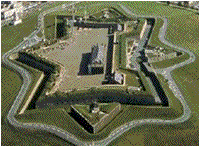
Fort Halifax
In the southern theater, Americans find another victory at Cowpens, South Carolina as General Daniel Morgan defeats British General Tarleton.
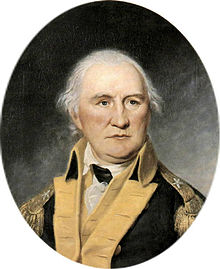
General Daniel Morgan
General Morgan was a prisoner of war captured during one of the battles of Quebec and Montreal, while under command of Benedict Arnold, and was released in a prisoner exchange 8 months later. Arnold's treason was viewed as humiliating to the country and the cause of the patriots.
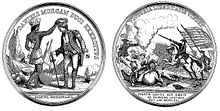
Designs for the 1981 Commemorative Silver Dollar of the 200th anniversary of General Morgan's Battle of Cowpens. Morgan's actions would be merged with the accounts of several other Patriot heroes in the 2002 film "The Patriot."
The Battle of Cowpens occured on the 17th of January, where Morgan was joined by militia under Andrew Pickens, and dragoons under William Washington. The British legion under Tarleton was supplemented by light infantry from several regiments of British regulars.
Morgan's plan took advantage of Tarleton's tendency towards quick action and general disdain for the militia, along with the longer range and accuracy of his Virginian riflemen. The marksmen were positioned in front, then the militia, then the regulars on the hilltop. The first two units were to withdraw as soon as they were seriously threatened, but only after inflicting damage, so as to invite a premature charge by the British. This tactic of Morgan's resulted in what was called a 'double envelopment.' As the British forces approached the Americans, whose backs were turned on the British, the Americans reloaded their muskets and fired point-blank in the faces of their onrushing foes as they got too close.
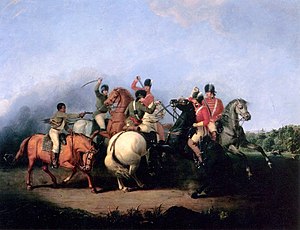
Battle of Cowpens, by Louise Gespard, Quebec City Museum of Science and History, 1848. Gespard was the grandson of a Quebecker who fought with Morgan, and heard tales of his deeds by his grandfather.
In less than one hour, Tarleton's 1,076 men faced 119 killed and 842 captured, including 212 wounded. Although Tarleton escaped capture, the Americans did capture all his supplies and equipment, including the officer's slaves. Morgan's cunning plan at Cowpens would be widely considered to be the tactical masterpiece of the war, and one of the most successfully executed double envelopments of all modern military history. Several towns, counties, rivers, mountains, and islands would be named after the general in the years to come.
[/FONT]
Following this great victory, the patriots had a small victory on St. John's Island, where hundreds of settlers owing Quit-Rent ousted the small British garrison there. Walter Patterson, seeing the tides of sentiment as well as being influenced himself by Jonathan Eddy's success, and the success of the Quebeckers, began openly expressing patriot sympathies this winter, and helped organize supplies for the patriots in Nova Scotia.
Even with their victories, there were more troubles for the Americans as well, with another mutiny amongst the troops in Pompton, New Jersey, this time being put down by a 600-man force sent by General Washington seven days later. Two of its leaders were promptly hanged.
Fort Nassau, having been American-held for some time now, sends four ships to the Turks and Caicos Islands, under John Paul Jones, meeting up with the French occupying the islands at the time. The Americans would garrison several dozen there with their families until the fall.
[FONT="]
February brought more success, in a roundabout way, to the Patriot cause, as General Morgan ordered 500 militia under General William Lee Davidson at the Battle of Cowan's Ford, which served to help to slow Cornwallis' crossing of the Catawba. The British lost several cannon, horses, and men with the militia picking off their soldiers, but they inflicted more damage to the Americans, including a shot to the heart of Davidson, who was found later that night naked, and robbed by British soldiers, proven by his wallet being returned from the Public Records Office in 2001.
In the Caribbean, the Battle of Sint Eustatius brought the capture of the Dutch island, a source of much piracy in the West Indies. Nearer to home, the French and Spanish soldiers capture Minorca from the British in a months-long siege on the fifth of February.
The Americans adopt the Articles of Confederation on the 2nd of March, which included signatures by representatives from Quebec and Nova Scotia, both having representative governments at this point. Several states dragged out the process, when they refused to cede their land claims to the west. Quebec did not give up their claims to the Ontario peninsula, but did cede the northwest area from Lake Nipising.
At Guilford Courthouse, North Carolina, the British win a costly victory, when General Cornwallis defeats Nathanael Greene; Cornwallis' 1900 men defeated the larger American force of 4000, though it would be a costly victory with several ramifications for the future of the British Empire and Africa. Cornwallis was determined to destroy Greene's Army after Cowpens, though the loss of his light infantry led him to burn supplies to be nimble enough to pursue Greene. He chased Greene in an attempt to prevent his escape across the Dan River, which failed. Establishing camp at Hillsborough, his forces foraged for supplies and recruits from amongst the North Carolina Tories. Unfortunately for Cornwallis, the poor state of his army, and Pyle's Massacre deterred Loyalists from turning out.
Due to the fighting, thousands of slaves escaped their plantations in the south, with many having joined the British to fight for their personal freedom. In the waning months of the war, the British evacuated more than 3,000 freedmen to Cuba, British Honduras, and Australia, and eventually New Caledonia. Northern slaves who escaped to the British lines were brought first to Newfoundland, then later to British Guyana, Sierra Leone, Cape Colony, and British South America in the next thirty years. The large numbers of freedmen across the Caribbean helped spur the abolitionist movements in the Empire, along with the 'repatriation movement' of creating a freedmen's colony in Africa for the freed Africans to return "home."
On March 14, while Cornwallis was encamped in the forks of the Deep River, he was informed of Greene's encampment at Guilford Courthouse, with North Carolina militia and reinforcements from Virginia and Maryland, totaling around 4,000-5,000 men. He decided to take the initiative and fight, even though he only had 1,900 men. He detached 120 men under Lieutenant Colonel Hamilton with his baggage train to Bell's Mills, and set off before breakfast for Guilford, arriving near midday.
[/FONT][FONT="]The battle lasted only 90 minutes, and even though he had his horse shot out from underneath him, General Cornwallis won the fight, though with heavy losses made fighting through the first two lines of the Americans. He ended the fight with 93 dead, over 400 wounded; Greene reported a total of 1,046 missing, 79 killed, and 185 wounded. He retreated without chase from the British, who had less than 2,000 men available for it. Instead, he decided to leave Hillsborough, where he spent only a few weeks, to march to Wilmington, North Carolina for refit and recruitment. Instead of remaining to reinforce his position here, General Cornwallis decided to march to Virginia, believing that until he reduced Virginia, he could not securely hold the other southern colonies he had just overrun.
For three months, Cornwallis raided every farm and plantation he came across on his way, and took hundreds of horses for his Dragoons, converted around 700 infantry to mounted duties, and freed thousands of slaves, of which 12,000 joined his own force. American General Greene pushed towards Camden and Charleston, hoping to draw Cornwallis back towards him, along with drawing back Lord Rawdon, whom Cornwallis had left in the field at Guilford Courthouse. Greene faced numerous hard battles and repeated reverses in his attempt to recover the southern states, but largely succeeded by the end of the year. He was quoted as saying, "[/FONT][FONT="]We fight, get beat, rise, and fight again." (This line would later make it into the film "Greene's Men" in 2004.) Cornwallis' move north makes possible the Battle of Yorktown later.
March also brings with it a force of six British vessels to Quebec City, hoping to take the city back; though they bombard the city, Patriots successfully defend against the cannon, forcing their retreat back up the St Lawrence, and eventually to port in Newfoundland. Another force sailed for Montreal, bombarding that city as well, though three American ships at port were able to defend the city and force the retreat in the Battle of Montreal, led by Colonel [/FONT][FONT="]Barthélemy Faribault, who later brought a number of veteran settlers in to St Ignace, in the future state of Manitoulin.
[/FONT]
[FONT="]In April, General Greene faced another defeat at Hobkirk's Hill on the 25th, South Carolina, by Lord Francis Rawdon, followed by an expulsion from Halifax by the British Navy. Colonels Eddy and Viger vow to return to retake the city. Despite these two setbacks, General Bédard managed to successfully defend Montreal from a British force led by General William Robertson, leading a force of 1,800. Bédard declared Rupert's Land United States Territory, though he did not have the manpower to cover the large territory, and it would remain British territory at war's end.
On May 15th, British Major General Andrew Maxwell ceded Fort Granby, South Carolina to patriot Lieutenant Colonel Henry Lee, in one of a series of reversals for the British this year, including the recapture of Augusta on the 6th of June.
Generals Washington and Romchambeau, the French general, met in Connecticut on the 21st for a war council. Romchambeau reluctantly agreed to Washington's plan for a joint French naval and American ground attack on New York.
June was a close month for the Patriots, when Thomas Jefferson narrowly escaped capture by the British at Charlottesville, Virginia, followed closely by the recapture of Augusta. Under the joint command of Marquis de Lafayette, General Anthony Wayne, and Baron von Steuben, Americans form a combined army to oppose the British under Cornwallis and the traitor, Benedict Arnold. At Ninety Six, South Carolina, the British hold off the Americans, who were led by General Greene. In July, "Mad" Anthony Wayne was repulsed at Green Springs Farm in [/FONT][FONT="]Virginia.
By August, after several months of chasing Greene's army through the south with little success, General Cornwallis and his 10,000 tired soldiers arrived to seek rest in Yorktown, Virginia, on the Chesapeake Bay. Hearing of this, General Washington abruptly changed his plans, and abandons the New York attack in favor of Yorktown, after he received a letter from French Admiral Comte de Grasse, indicating that his entire 29-ship French fleet was then heading for the Chesapeake Bay, near Cornwallis. Washington coordinated with Rochambeau to rush their best troops south to Virginia to destroy the British position at Yorktown, leaving behind a token force to make the British believe they would still attack in the north. Another French fleet, under Count Le Fleur, laid siege to the British ships at Halifax, having coordinated with Bédard and Eddy for a dawn attack against the fort there.
Comte de Grasse's French fleet cut off the sea retreat from Cornwallis, and landed troops near Yorktown, which linked up with Lafayette's American troops, cutting off the option of a land retreat.
By September, General Greene's troops were defeated at Eutaw Springs, though this defeat had the effect of forcing the British to abandon most of their southern conquests outside of Charleston and Savannah. As before, Greene faced several reversals on the field before the defeat, which ultimately played into the Americans' favor. Back at Yorktown, a major naval battle between Comte de Grasse's French fleet and British Admiral Thomas Graves resulted in a victory for de Grasse, leaving the French fleet in control of Chesapeake Bay when they retreated to New York for reinforcements. The French established a blockade, cutting off Cornwallis from any hope of retreat by sea. Some French reinforcements arrived from Newport and Halifax, 12 ships in total, demonstrating their control of the sea.
Benedict Arnold burned the port of New London, Connecticut, under orders from General Clinton to attempt to divert General Washington from marching towards Cornwallis in Virginia. On the 6th of September, in what would later be called the Battle of Groton Heights, or the Fort Griswold Massacre, where the defending militia under Lieutenant Colonel William Ledyard faced the numerically superior British forces of Arnold and Lt. Col. Edmund Eyre.
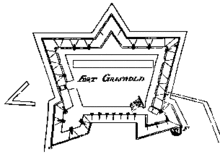
Sketch of Fort Griswold by Arnold
The militia resisted British attempts to capture the fort, located across the Thames River in Groton, with several leaders of the attacking British force either being killed or seriously wounded, and much of the defending garrison being eithier killed, mortally wounded, or captured when the fort was eventually stormed. High British casualties (49 killed, 145 wounded) led to criticism of General Arnold by his superiors, and was the last major northern battle in the United States, preceding the decisive American victory at Yorktown by about six weeks.
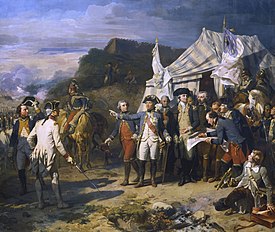
Washington and Rochambeau giving their orders before the battle.
The French de Grasse sent ships up the Chesapeake to transport Washington, so that by the 27th, General Washington could begin his siege of Yorktown with his combined allied army of 17,000 men. French cannons bombarded Cornwallis and his 9,000 men from the sea day and night, while the allied lines slowly advanced to encircle him. Lasting several weeks, the constant attacks drained Cornwallis' supplies to dangerously low levels.
On October 9th, Washington fired the first gun after all were in place. Legend has it that its ball smashed into a table where British officers were eating at the time.
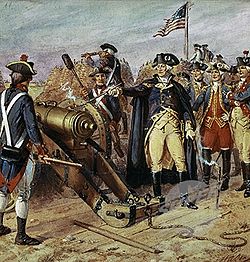
Washington firing the first gun.
The Americans approached closer and closer, digging under cloudy skies, reaching just out of musket range, then reaching and storming the redoubts of the British.
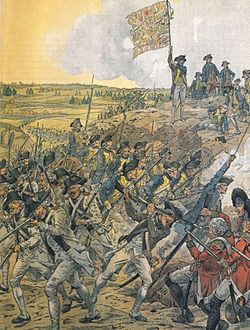
Storming of Redoubt #9
An assault by French troops occurred simultaneously, on the Hessian positions, hacking at the abatis, and successfully climbing over the fortification, forcing a Hessian surrender when they saw the French preparing a bayonet charge. The Americans were able to shell the city from three sides, and when a random squall prevented escape across the river, Cornwallis finally decided to surrender on the 17th.
Cornwallis ordered his Lieutenant Colonel Thomas Dundas to discuss terms of surrender, and the Americans sent a Lieutenant Colonel, Laurens, with the Marquis de Noailles to discuss surrender. On the 19th, Brigadier General Charles O'Hara presented the sword of surrender to Rochambeau, who shook his head, and pointed to Washington. O'Hara offered it to Washington, who refused to accept it, motioning to his second in command, Benjamin Lincoln, who had been humiliated by the British at Charleston, to accept it.
With the surrender, the British soldiers marched out and laid down their arms between the French and American armies, while many civilians watched.
Seven thousand British reinforcements under General Clinton arrive nearly a week later at the Chesapeake, but turn back upon hearing of the Yorktown surrender. In November, Governor Walter Patterson ended Quit-Rent on the island, and re-assigned land grants to the current landholders, in allodial title.[/FONT]
JJohnson
Banned
A side story of the alternate timeline.
Von Steuben Elementary, Bismarck, Florida, 1976.
Little Tommy took out his letter he kept in a protective plastic sheet, holding an original, signed letter of recommendation by General Washington, kept in his family since the American Revolution. It would be donated to the Smithsonian Museum Annex in Alexandria, DC by his family in time for the Bicentennial celebrations in July.
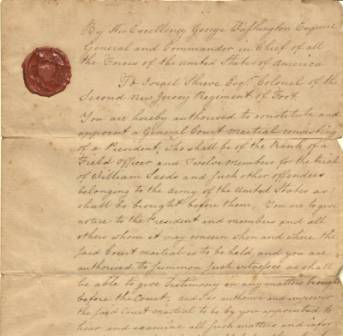
For show and tell at his second grade class that late April day, Tommy Dhom would tell how his ancestors came over from Bavaria, and helped fight in the Revolution, trained under Baron von Steuben with George Washington, then settled in South Carolina.

Mecklenburg County family house
Jakob Dhom married Abigail Saylor in 1781, two years before the end of the Revolution. As it ended, they moved to South Carolina, where they became farmers, and raised a large family.
His family farmed in Mecklenburg County until 1850, when it decided to move south into the new state of Florida. They spent time in Columbia County, Duval County, and then south to Bismarck County in the middle of Florida, where most of Florida's theme parks currently reside.
Still holding on to their German heritage, the Dhom family has continued to speak German in the home, teaching it to all their children, reading two of Florida's five German-language newspapers, while embracing their two centuries of American heritage. They eat Würstchen while enjoying grits for breakfast, and play baseball and soccer. They go hunting and his parents help out with the Parent-Teachers' Associations. Tommy's grandparents and great-grandparents fought in three wars when drafted, earning three Purple Hearts between them, and his great grandfather, William Dhom, rose to the rank of Colonel in the US Army by 1918.
His grandfather, James Dhom, served in the Army, helping recapture the Caroline Islands (German: Karolinen) from the Japanese in the early 1940s before settling down in Arizona along its Gulf of California coastline in Stanton [OTL Puerto Penasco, Mexico], then returning to central Florida in the 1960s.
Tommy's show of the letter got him a lot of questions from his classmates, with which his mother helped when he didn't know the answers. The Dhom Family's story is like that of a number of families we have been highlighting in this bicentennial year, having come to America from both the United Kingdom and Europe, building a life, and becoming part of this American family that we celebrate today, its two centuries of freedom and liberty a beacon for the world. God Bless America!
Excerpted from the Florida Times Union, translated from the Florida Amerikanische Zeitung.
JJohnson
Banned
The Revolution finished in 1783, leaving a different world than we know.
The War is ended. Long live the United States of America.
[/FONT]
[/FONT]
[FONT="]The Revolution: The Final Years, (c) 2001
After the Battle of Saratoga, the writing was on the wall concerning the direction of the war. Starting in January, a number of Loyalists begin leaving America, heading south towards the colonies of Cuba, Jamaica, and the Providence Islands. In all, around 15-20% of Americans resettle, including between 75,000 - 100,000 Black Loyalists, who follow to lands elsewhere in the British Empire. The arrival of so many "free-men" in Cuba, a slave-holding colony, would also begin to spark the 'Back to Africa' movement, for a free-black colony, and start British interest in the continent for regular settler colonies. This movement of people is marked by historians as the beginning of the 'Second British Empire.' Movement of American 'resettlers' would also lead to the rhotic quality of the early Australian and Cuban English accents.
By the end of January, the British had withdrawn from North Carolina. The House of Commons votes against further war in America in February, while fur trappers begin evacuating Rupert's Land, fearing Quebecker invasion to the north and west, which never materializes. On the 22nd, the French capture Montserrat from the United Kingdom, though it would be returned in the pending Treaty of Paris.
In March, the Parliament of the United Kingdom empowers the king to negotiate peace with the United States. Lord North resigns as Prime Minister on the 20th, and succeeded by Lord Rockingham, who then seeks immediate negotiation with the American peace commissioners.
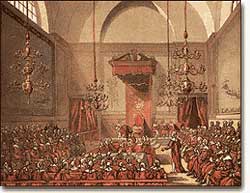
As the fighting dwindled, American militiamen massacred 96 Delaware Indians in the Ohio country in retaliation for Indian raids conducted by other tribes.
British General Clinton began to oversee the end of hostilities as April came, with the start of the withdrawal of British troops from America. With no place to go other than the frigid north of Rupert's Land, and the unfriendly island of Newfoundland, the General would send a letter to Lord Rockingham suggesting resettlement across the British Empire for Loyalists and troops, with free passage for troops and land available for them when they arrived.
In Paris, Benjamin Franklin and Richard Oswald of Great Britain would begin their peace talks between the two nations. The Dutch recognized the young United States of America as a result of negotiations conducted in the Netherlands on the part of John Adams.
Thomas Tingey defeated Governor John Montagu at St. John, Nova Scotia on the 18th, with a force of 2000, capturing the vital seaport. The Patriot's demand annexation of St. Pierre and Miquelon, and capture of Newfoundland Island, but with the war winding down, the Navy and Army scrap any plans to do so, and the Treaty of Paris will specify that those islands remain French. General Washington established an American army headquarters at Newburgh, NY.
In June of this year, the British withdrew from Savannah, while in the Great Lakes, one of the last battles of the Revolution occurs when several Quebecois Patriots take a fur trading post from the British near the northern border of the future state of Minnesota. Congress adopted in June the Great Seal of the United States, with 15 arrows, leaves, and stars on it, representing the original 13 colonies which revolted, along with Nova Scotia and Quebec.
By August, some dwindling fighting continued as Loyalist and Indian forces attacked and defeated American settlers near Lexington, Kentucky. Mohawk Indian Chief Joseph Brant conducted raids on settlements in Pennsylvania and Kentucky, while Americans and British fight in South Carolina along Combahee River. The final battle occurs in November with Americans retaliating against Loyalist-Indian forces by attacking a Shawnee Indian village in Ohio country.
The British signed the preliminary Articles of Peace in Paris in November, and left Charleston, South Carolina in December. In France, strong objections to the peace treaty signing without consulting them first nearly caused a falling out with France, though Ben Franklin soothed their anger with a diplomatic response.
1783
The United Kingdom signed a preliminary peace treaty with France and Spain in January, wherein the British yield East and West Florida to Spain, in exchange for the Bay Islands, Providence Islands, and settlement near the Falklands south of the Viceroyalty of Rio de la Plata, where there were no other settlements. This would later lead to a clash between Spanish and British settlers, culminating in the future Invasion of the River Plate in 1806. Britain yielded the Mosquito Coast claims in exchange for expanding British Honduras inland.
In February, Spain recognized the United States, followed soon after Denmark, Sweden, and Russia. England officially declared an end to hostilities in America soon afterwards.
An anonymous letter circulated in March among Washington's senior [FONT="]officers at Newburg, NY calling for an unauthorized meeting, urging officers to defy the authority of the new US Congress for its failure to honor past promises to the Continental Army. The next day, General Washington forbade the unauthorized meeting, and instead suggested a regular meeting March 15. A second anonymous letter then appeared claiming falsely that Washington himself sympathizes with the rebellious officers. To resolve the issue, General Washington gathered his officers on the 15th, and talked them out of a rebellion against the authority of Congress, in effect preserving the American republic[/FONT] on that day. He stumbled on the letters, and took out his glasses, which few had ever seen him wear before, telling his soldiers:
"Gentlemen, you will permit me to put on my spectacles, for, I have grown not only gray, but almost blind in the service of my country."
As he read, soldiers began openly weeping, and any talk of rebellion fell apart that day, preserving the republic.
As April came, Congress officially declared the end of the Revolutionary War. On the 26th, 7,000 Loyalists sailed from New York to the New Providence Islands, bringing the total to 123,000 Loyalists who left America.
By June, the main portion of the Continental Army had disbanded, as Congress leaves Philadelphia, and relocated to Princeton, New Jersey to avoid protests from angry and unpaid war veterans. On the 11th, Daniel Cartwright would be born to George and Juliana Cartwright on Newfoundland Island, which remained British throughout the war. He would grow up to become the colonial governor of Newfoundland, responsible for succeeding in gaining responsible government for the island.
In July, the Supreme Court of Massachusetts abolished slavery in that state, beginning the rollback of the 'peculiar institution' in North America.
On September 3rd, the Treaty of Paris was formally ratified by the representatives of the United States and the United Kingdom. Congress would ratify the treaty on January 14th of the following year.
As the year drew to a close, Virginia's House of Burgesses granted freedom to slaves who served in the Continental Army in October, while General George Washington delivered his farewell address to the army, followed the next day by the discharge of his remaining troops.
Colonel Eddy made known his intent to retire to Halifax, the new capital of Nova Scotia, which had just signed the Articles of Confederation in October. Washington entered Manhattan as the last British troops left, while Congress met in Annapolis, Maryland.

Colonel Eddy
At Fraunces Tavern on December 4, Washington formally bade his officers farewell and on December 23, 1783, he resigned his commission as commander-in-chief in Annapolis before Congress. Historian Gordon Wood concluded that the greatest act in his life was his resignation as commander of the armies—an act that stunned aristocratic Europe. King George III called Washington "the greatest character of the age" because of this.
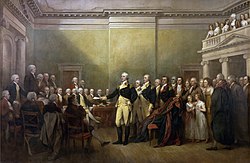
General Washington, resigning his commission.
[FONT="]Pierre Bédard and Jonathan Eddy also resign their commissions to return home following Washington's example.[/FONT]
The War is ended. Long live the United States of America.
[/FONT]
[FONT="]The Territorial Evolution of North America, (c) 2010:
The United States of America included:
The thirteen colonies of Georgia, South Carolina, North Carolina, Virginia, Maryland, Delaware, Pennsylvania, New Jersey, New York, Connecticut, Rhode Island, Massachusetts, New Hampsire, along with the colonies of Quebec, Nova Scotia, Bermuda, and the Bahamas. The western border of the United States came to the Mississippi River to the west, and north to the St. Lawrence watershed, leaving the Hudson Bay watershed as part of Rupert's Land.
The United Kingdom retained the Island of Newfoundland and Rupert's Land, out to the Hudson Bay watershed, south to the 49° parallel, west to the Pacific. Cuba, Jamaica, the Providence Islands, Bay Islands, and its other Caribbean Islands remained in the Empire.
France retained St. Pierre et Miquelon, and its Caribbean territories, while Spain retained its Floridian and Caribbean Empire. Sweden and Denmark kept their Caribbean territories by 1784.
[/FONT]
JJohnson
Banned
For Great Britain, are there any alternate possible Prime Ministers we can have instead of Pitt? I'm looking for someone who would help bring about both Catholic Empancipation after union with Ireland and increased colonization of the Empire to help tie it closer to the home country.
Last edited:
JJohnson
Banned
A little blurb on King George II:
History of the United Kingdom of Great Britain and Ireland, (c) 1952.
Settling the Empire
King George II, having gained the colony of Cuba in the War of Jenkin's Ear, and secured it from the Spanish through the valiant efforts of Admiral Vernon, set about securing settlers for his territory. Settlers from Great Britain, as well as the Electorate of Hanover, were allowed land on the island, and later, due to his aid in the Seven Years' War, Frederick II, the Great, gain concession from his cousin to open settlement to his subjects.
After the loss of British North America, the United Kingdom's settlers flowed towards Cuba, Providence Islands, Jamaica, and British Honduras. With the opening of New Caledonia, New Zealand, and Australia to settlement, many Loyalists began settling there, including Hanoverians, and Brandenburg-Prussians, along with Hessian mercenaries who had fought under the British crown.
Continuing his father's policies of encouraging settlement, King George III, after the loss of much of North America, sought other areas for settlement, leading to the Invasion of the River Plate in 1797, capturing Montevideo and Buenos Aires, with the support of a number of natives, based on the plan of Nicholas Vansittart. Though they later rebelled, the aristocracy fell to the waves of British, and later German-speaking, settlers. The War of the River Plate followed by the Treaty of London (1800), where Spain settled its borders with the United Kingdom, ceding the southern cone of South America to the United Kingdom, where waves of English, Scottish, and Irish settlers arrived, along with other European settlers seeking land and escape from the crowded cities of Europe. Though Vansittart planned to take the land all the way to Peru, his plans were later modified by the reality of the situation and by gentlemen such as Thomas Maitland, who brought British ambition more in line with what they could accomplish, namely the capture of the land south of the Bermejo river, west to the Pacific, and east to the lands surrounded by the Parana River. Whitelocke, Beresford, Popham, and Frederick Adam conducted the operation, largely successful due to the distraction of the Spanish Empire with the Napoleonic Wars.
The British South America colony, as it was called from 1800-1827, grew in fits, starting on the east coast and working its way inward, with a number of settlements, chiefly Bonnaire (Buenos Aires), the capital of the colony, and Whitelocke (Montevideo). New Belfast (OTL Viedma) on the Black River in South America, and New Galway (OTL Castro) on the west coast, south of the Hessian settlement of Neupforte (Newport, OTL Puerto Montt) became growing settlements. For their part in the Napoleonic Wars, King George III, and later, George IV, encouraged settlement of veterans and their families in the British Empire, leading to Swedish, Prussian, Genoan, Swiss, and Italian immigration into the inner territories of the colony.
The Cape Colony became another destination for British settlers, on the way to British India, having been annexed in 1806. To aid in their frontier wars with the Xhosa, the government of the United Kingdom encouraged the 1820 Settlers (12,500 English, Scottish, and Irish; 8700 Dutch-Flemish), a large number of them unemployed Dutch, whose passage to the eastern part of Cape Colony came with the Agreement of 1820, where the Dutch Trading Company (founded 1820 by King Willem I) would gain access to markets in Cape Colony, improving the situation in the southern United Kingdom of the Netherlands dramatically.
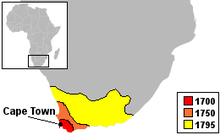
Dutch Cape Colony, up to 1795
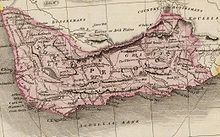
British Cape Colony, 1815
The incoming Dutch formed a border with the Boers, and owing their allegiance and livelihoods to the British crown, formed a linguistic stratum that contains a range of accents from the Boer settlers and Dutch immigrants from Flanders and the northern Netherlands, now called Cape Dutch, which is to this day mutually intelligible with European Dutch. Southern Netherlanders, speaking French and also being Catholic, came to settle both the River Plate colony as well as the Cape Colony, forming the town of South Liege (now a suburb of New Belfast, OTL Viedma) on the Black River in 1819, and South End (Zuidend), just north of Durban, which was founded in 1824.
The British annexed the "Republic of Natalia" in 1843, and with annexation came a British governor and a flood of settlers, this time mainly from the Netherlands, Hanover, and Ireland. The Voortrekkers moved north, establishing what became known as the Orange Free State.
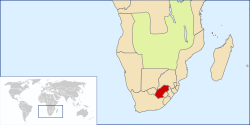
Orange Free State in the southern portion of Africa
The Orange Free State and the Transvaal later fell to British forces in the Boer War of 1862-64, when a gold rush brought the two Boer Republics into conflict with the inrush of British/Dutch settlers.
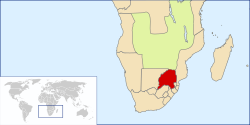
Transvaal in southern Africa
The Griqua mini-states allied with the British in the face of the overwhelming show of force, being annexed to the British crown, while in practice largely ruling themselves.
With the abolitionist movement succeeding in outlawing slavery across the British Empire, large numbers of newly freed blacks outnumbered a lot of British settlers in the Caribbean, creating a lot of tension with the British settlers and their former slaves. The colony of Freetown, established in 1792, was established for that purpose. It became a Crown Colony in 1808, and after 1834, population crept inland to the north and east with thousands of freedmen and British tradesmen, increasing as gold and diamonds were discovered, taking the name British Guinea (OTL Sierra Leone and Guinea).
British encroachments into the continent drew the attention of the French, Portuguese, Spanish, Italian, Dutch, and even some German states, leading to the decades-long 'Scramble for Africa' that historians tend to date back to around 1836, as Europeans sought new colonies and resources to exploit, along with new settler colonies for growing populations.
JJohnson
Banned
Loyalists and their impact on the British Caribbean...
Famous United Empire Loyalists
Colonel Arent DePeyster left North America in 1783 for Cuba, settling in the western portion of the island in Swansea (OTL Vuelta Abajo), along with David Fanning, who began growing tobacco, beginning the Fanning Tobacco Company.
Fanning settled down with a native Cuban, Sarah Foster, having five children by her. His son, William David Fanning, left Cuba in 1805 for New Belfast (OTL Viedma), beginning a settlement across the river later called Amelia, after the county where he was born in Virginia.
Daniel Leonard moved to Belize City, beginning a furniture working business that later became Leonard's Department Store, then finally merged with Hamilton's Electronics, becoming Leonard & Hamilton (Stock: LH), based in Belize City, with stores in Cuba, British Guiana, South Africa, the United States, and the United Kingdom.
William McCormick opened a new business in British Cuba in 1784, later moving from Bay Town (OTL Baracoa) to Kingsport (OTL Havana), with his sons later building on his company, becoming a major radio and telecommunications company in the 20th century.
Edward Jessup left the North American continent and settled in Newfoundland, founding the town of Prescott with his son.
JJohnson
Banned
The United States under the Articles of Confederation
Territorial Evolution and Strengthening of French in the United States
(c) 2001
Since its adoption in 1781 by all 15 of the 15 colonies, the Articles of Confederation have served as the governing body of the United States.
The Congress of the Confederation served de jure starting in 1781 as the legal government of the fifteen states. The first state to sign was Virginia, followed by South Carolina, New York, Nova Scotia, Rhode Island, Connecticut, Canada, and thence the rest of the colonies.
The government was designed to avoid a strong central government, since the experience of the colonists with King George III was fresh in their minds when they drafted it. The states guarded their sovereignty with jealousy, and intentionally designed the Confederation to avoid an executive.
One of the biggest successes was the Northwest Ordinance, along with the Land Ordinance of 1785. These acts created territorial government, set up protocols for the admission of new states, the division of land into useful united, and set aside land in each township for public use. This would be a sharp break from the European pattern of colonization, and provided the bases for American continental expansion throughout the 19th century.
The Land Ordinance of 1785 established the general practices of land surveying in the west and northwest, and the land ownership provisions used throughout the later westward expansion beyond the Mississippi River. The Northwest Ordinance of 1787 was an agreement for the original states to give up all western land claims, west of the Appalachians and the Ottawa River. It was also notable in abolishing slavery in the territories, and fixing between four and seven states. This territory would later become all or part of Ohio, Manitoulin, Ottawa, Michigan, Illinois, Indiana, Wisconsin, and Minnesota.
Unfortunately for the Confederation, it could only ask for money, having no power to tax, and could not raise an army to defend against Indian raids or remove British from the frontier in accordance with the Treaty of Paris in 1783. John Adams could not secure a treaty in London for trade, inability to protect manufacturing and trade, and depreciated currency threatened the new country. Historians commonly cite Shay's Rebellion, over payment of taxes, as having a role in the shape of the future government under the Constitution. By 1787, the urge to revise the Articles of Confederation grew, leading to what would become the Constitutional Convention.
Territorial Evolution and Strengthening of French in the United States
One lasting thing coming out of this would be the strengthening of French as a second language in the future United States, with the addition of multiple states which had French as their first or second language. Canada styled itself as "Quebec" starting in 1785, while the Northwest Territory would be split into three territories: Ohio Territory to the east, Indiana Territory to the west, and north of the Great Lakes, Canada Territory.
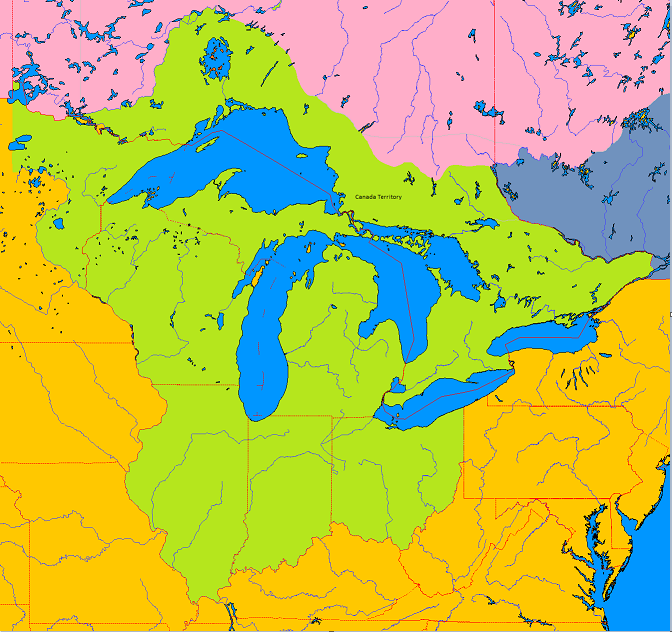
In 1800, Congress divided the Northwest Territory at the junction of the Ohio and Great Miami River due north to the Great Lakes, creating the Ohio Territory at the east, where American settlements were increasingly being established, while the west was renamed the Indiana Territory, and the land north was named Canada Territory.
The Canada Territory was settled starting in 1787 by settlers from Quebec, followed soon after by Pennsylvanians, New Yorkers, and other English-speaking settlers. By 1802, the territory would be split into the Ottawa Territory at Lake Nipissing, and the Canada Territory, while Ohio got a new northern border to include Toledo, taking a portion of Michigan so it could keep its valuable port.
Indiana's northern border was moved ten miles north of the southern point of Lake Michigan, taking the port of Eddy, Indiana (OTL Gary) from Michigan. The territory would lose territory again when the upper peninsula would be assigned to the Canada Territory. Michigan Territory then acquired its modern territory. Illinois gained several miles of territory to the north to keep the city of Chicago in its territory, leaving Wisconsin for a few years with the Upper Peninsula, which was later assigned to Canada Territory. Michigan did retain, however Bois Blanc Island, as well as Beaver Island.
The eventual state of Wisconsin would win territory in its assignment of which branch of the Montreal River would form its northeastern border, getting the eastern branch.
In the end, the territory would be divided into 7 states, with three, Ottawa, Michigan, and Manitoulin, having significant (>10%, and in the case of Ottawa, >20%) population of French-speaking settlers. While these states would conduct their affairs in English, government affairs could be conducted in French on request of any settler, and to this day, French language skills are a requirement for government employment in these states. To the east, Nova Scotia and St. John's Island also offer today government services in French upon request, along with Maine, New York, and Louisiana.
JJohnson
Banned
Endangered Species
For those reading in this thread, what are some endangered species that have gone extinct since 1780, or are not critically endangered that can be spared TTL? I've heard of the Iriomote Cat, Tasmanian Wolf, American Bison, and Persian Leopard, but are there any other animals that could be saved perhaps? I'm going to try to figure a way for some individual or group to start a conservationist movement and perhaps start up some zoos, ranches, or preserves to keep animals from dying out.
For those reading in this thread, what are some endangered species that have gone extinct since 1780, or are not critically endangered that can be spared TTL? I've heard of the Iriomote Cat, Tasmanian Wolf, American Bison, and Persian Leopard, but are there any other animals that could be saved perhaps? I'm going to try to figure a way for some individual or group to start a conservationist movement and perhaps start up some zoos, ranches, or preserves to keep animals from dying out.
JJohnson
Banned
The Rise of European Colonialism, beginning in 1783-1815.
The History of European Colonialism, Chapter 5: The Dutch Empire
After the Congress of Vienna, the Netherlands and the Southern Netherlands merged to form the United Kingdom of the Netherlands, and the Grand Duchy of Luxembourg was in personal union, though part of the German Confederation.
For their part in the Coalition, and through some efforts of William Carleton, the son of Governor Carleton of the colony of Cuba, who fought in both the Caribbean and in Europe in the war, on behalf of Hans von Gagern, the Netherlands managed to negotiate some additional concessions from the Great Powers: the county of Dunkirk, which had a historically Flemish-speaking population, the entire island of Saint Martin, which joined the other island possessions of the Netherlands, namely Saba, Sint Eustatius, Bonaire, Aruba, and Curaçao.
The Dutch lost South Africa to the United Kingdom, but were granted colonization rights in a separate agreement after the end of the Congress of Vienna, which gave the British a steady stream of colonists, so long as they obeyed British law and conducted their affairs with the government in English. In practice, however, the influx of Dutch to the east, along with French-speaking Dutch in the upper interior of the Cape Colony solidified the practice of speaking Dutch in the east, French in the north, and English in the west of what would eventually become South Africa. The Dutch of South Africa tended towards a slightly German bent, with the addition of Hanoverian settlers, who, due to the royal family, tended towards the administrative positions in the east and west, along with native-born English-speakers.
Dutch Guiana thrived as a settler colony after the abolition of slavery in 1872, with the introduction of industrial plants in South Amsterdam (OTL Paramaribo), New Antwerp, and Lelydorp. Electricity was introduced in 1899 in some buildings in South Amsterdam, then rapidly over the next 10 years, followed by power lines to several other towns. The colony had a very distinct Dutch flavor to it, with cities that consciously resemble those found in the United Kingdom of the Netherlands in Europe itself. Dutch immigration continued to the Caribbean throughout the 19th and 20th century, with Dutch Guiana reaching 382,000 by 1900, with approximately 86,000 Wallonians throughout the territory.
After 1850, the Dutch turned their attentions to Africa, where the British and the various German territories had made a number of trading posts and early settlements. Though the Dutch made a few outposts along the coastlines, it wasn't until the first Congress of Berlin in 1859, where they got a settled portion of the continent, founding Zwartpunt in 1861 (OTL Pointe-Noire), followed by Willemstad in 1862 (named for King William II of the United Kingdom of the Netherlands).
The Grand Duchy of Luxembourg ended its personal union when the German Confederation ended in 1867, and remains independent to this day. The second Congress of Berlin, in 1886, formalized additional territorial changes in Africa, to avoid the minor colonial skirmishes that had been occurring across the continent. The Dutch came out with the least territory, but were granted port rights in any British colony in Africa as compensation. The Dutch colony of the Netherlands Congo came out ahead, though, as diamonds were discovered in the eastern portion of the colony, along with uranium and manganese, as well as oil in the coastal region.
Mining formed a large part of the eastern territory's economy for the later half of the 19th century, and with the import of automobiles in the early 20th, oil became important after the second Great War. Thousands of Netherland veterans, both Dutch and French speakers, chose to move to the Netherlands Congo, joining in the oil industry and the diamond industry, striking it rich and bringing with them new developments from Europe in telephony, automobiles, electricity, television, and radio. Soon additional cities sprung up, with the capital moving from Zwartpunt to Willemstad in 1951 to be more centrally located. Racial tensions continued, with many ethnic Africans having fought in the Netherlands army and navy for their land, coming back to discrimination and segregated facilities, which helped birth the civil rights movement in the Dutch Congo. By 1962, the Netherlands Parliament passed a measure to end racial segregation, followed in 1964 by an equal rights law forbidding hiring and education discrimination, and mandating percentages of admissions to go to ethnic Africans for a period of 20 years, provided they can speak Dutch and French, and assistance in starting new businesses. The measure included preferences for veterans of the Great Wars for education assistance.
From the 1960s to the middle of the 1970s, before the oil crisis hit in 1975, Dutch Congo experienced a period of marked racial tensions and several riots throughout its territories over past injustices and poor conditions in the inner cities, leading to an explosion of suburbs outward from the cities, unique to the Congo, and also to Dutch Guiana, as opposed to the European portion of the country. This period of time also brought with it the election of the first ethnic African representative to the Netherlands parliament, Willem Vroom, a descendent of Hendrik Vroom. His career spanned twenty years, marked by a passionate defense of his home as part of the United Kingdom of the Netherlands, despite the difficulties he faced in Africa, and his successful efforts to increase nuclear and hydroelectric power in the Congo, bringing cheap electricity to his part of the United Kingdom. Vroom's family is also considered an influential reason for the increase in the Wesleyan Methodist Church in the Congo, the third largest congregation after the Lutheran Church and the Catholic church.
Beginning in the 1970s, with the rapid industrial growth and massive increase in living standards of the Congoese, there came an increase in environmental concerns, notably sparked in the book "de groene aarde" (fr. "La terre verte"), with preservation of the native animals and environment, and cleaning up the pollution brought about by the industries in Willemstad and elsewhere. A series of laws passed in the early 1980s, spearheaded by Anton Boakye, the second elected ethnic African to the Netherlands House of Representatives, along with efforts back home, leading to a number of clean air and water standards, establishing national parks and preserves, zoos, and new zoning laws to prevent destruction of a number of native species and limit the introduction of new invasive species. Through Boakye's efforts, along with the Congo Green Party's efforts, the Congo's rivers are cleaner than before, and are safe for swimming or fishing. Lake Nord-Ndombe has become a popular fishing destination for competitions starting in the 1990s.
The use of the term 'Dutch Empire' fell out of favor in the 1960s, as integration movements amongst the ethnic Dutch in the overseas territories desired greater representation in the national parliament. Today, the country is referred to as the United Kingdom of the Netherlands, of which there are several countries who are considered equal parts: the Netherlands, Sint Maartin, Congo, Guiana, Aruba, and Curaçao. There are special territories for Bonaire, Sint Eustatius, and Saba.
The History of European Colonialism, Chapter 12: The Swedish Empire
After the end of the Napoleonic Wars, a number of European countries sought to end France's reach, including some veterans from the British Caribbean, where naval fighting kept up from 1811 to 1815. During the Congress of Vienna, the captured islands of Guadeloupe and Martinique were ceded to Sweden-Norway as compensation for the loss of Swedish Pomerania in mainland Europe. This, along with Saint-Barthélemy, formed the basis of the Swedish overseas empire.
From 1815 to 1820, the Swedish and Norwegians initiated the changeover of authority, which included removing any remnants of French rule, and deporting French citizens to Europe on return trips, which carried Swedish and Norwegian colonists to the islands. By 1830, approximately 18,000 Swedish-Norwegians settled the islands, replacing approximately 23,000 French and French slaves. The islands' economies experienced some slowdowns and setbacks due to inexperience on the part of the new administrators, which did not get back on track until 1852, with Johan Stackelberg's governorship in Guadeloupe setting an example for the other islands.
Slavery was abolished in the British Empire in the 1830s, but remained until 1858 in the Swedish islands under a graduated emancipation, where the slaves were required to profess Lutheranism, demonstrate knowledge of Swedish/Norwegian, and know a trade. Unfortunately, the ten-year process left most of the new freedmen beholden to the former masters in impoverished situations, which did not change much until the 20th century with the rise of tourism to the islands.
Sweden's union with Norway ended in 1905, and it kept the island possessions in the process. By this time, the colonization efforts meant that a large minority of Guadeloupe and Martinique were ethnic Swedish/Norwegian, and 2/3 of the population of Saint Barts was ethnic Swedish. As of 1926, the islands were reorganized as overseas territories, and in 1958, they gained representation in the Riksdag of Sweden. In 1971, the Swedish King purchased a house in Guadeloupe for a winter retreat that the royal family occasionally uses to host special events.
JJohnson
Banned
Early American History, to 1816
Excerpted histories of the United States, till 1816
Excerpted histories of the United States, till 1816
From Diplomatic History of the United States,
The Jay Treaty, 1794-1796
Negotiated by John Jay and William Grenville, the Jay Treaty, or the Treaty of London of 1794, achieved a number of objectives of both parties to the treaty. The British sought to improve relations with the United States, necessitated by its war with France, so as to prevent the US from falling into the French side of the war. From the American perspective, the most pressing issues were trade normalization with Britain, its leading trade partner, and resolving remaining issues from the Treaty of Paris.
The British had captured a number of neutral American merchant ships as part of their blockade of Revolutionary France, and British officials in Rupert's Land were supporting Indian tribes' resistance to American settlers around the Great Lakes. Quebec, and in the Ohio River valley, territory Britain had explicitly ceded to the United States in the Treaty of Paris.
The Americans fell into two camps in the new Congress, one side favoring the French, the party of Jefferson and Madison, and the Hamiltonian Federalists, who saw Britain as a natural ally. The Federalists sought normalization of relations with Britain, especially in trade. Hamilton himself set up a framework for negotiations, and President George Washington sent John Jay, Chief Justice of the Supreme Court, to London to negotiate a comprehensive treaty.
From the American perspective, the outstanding issues:
*The British were occupying forts withing US Territory in the Great Lakes region, at Detroit, Niagara, Oswego, Maumee, and Morrisburg in Quebec.
*The British were continuing to impress American sailors into British service.
*American merchants wanted compensation for the 275 merchant ships which the British confiscated in 1793 and 1794.
*Southern politicians wanted monetary compensation for slaves who were evacuated by the British army following the Revolutionary War.
*Merchants in both American and the Caribbean wanted the British West Indies, and especially British Cuba, to be reopened to American trade.
*The boundary with Rupert's Land was vague in many places, and needed to be more clearly delineated.
*The British were believed to be aggravating Native American attacks on settlers in the Northwest
Both sides achieved many objectives in the treaty. The British agreed to vacate their northern and western forts by June 1796 (which was done), and to compensate American ship owners (the British paid $11,736,275 by 1802). In return, the United States gave most favored nation trading status to Britain, and acquiesced to the British anti-French maritime policies. The United States guaranteed the payment of private pre-war debts owed by Americans to British merchants, which could not be collected in US Courts (paying ₤625,000 in 1802). Two joint boundary commissions were set up to establish the boundary line in the Northeast (it agreed on Lac Mistassini, and all rivers flowing into the Atlantic or St Lawrence or Great Lakes) and in the Northwest (this commission never met and the boundary was settled after the War of 1812).
Jay, a strong opponent of slavery, dropped the issue of impressment, which angered Southern slaveholders. Jay was also unsuccessful in negotiating an end to the impressment of American sailors into the Royal Navy, some being held at Newfoundland Island before sailing to England, which later became a major issue leading to the War of 1812.
Montreal Gazette, excerted from the 9 September 1794 edition,
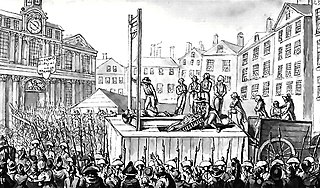
(translated from the original French):
The Terror of Paris, of which your papers do not tell you, is the device of the Girondins and Jacobins, both of which spread accusations and lies about their enemies. You are guilty until proven innocent, which often can be several weeks after your death. The revolution in France is not a birth of freedom, but mob rule at its worst. There are mass executions and political purges of enemies, all by the infamous symbol, the guillotine.
The leaders of this blasphemy of freedom are also the enemies of Christianity itself. They seized the property of the church, declaring it the property of the state. The National Assembly then dissolved the priests' oaths to God, made them beholden to a civil constitution, and subjected priests to a popular vote, including oaths of loyalty to the state. Convents and monasteries have been seized and turned into prisons for any priests or royalty who refuse to abide the Assembly. The priests heroically refused, their loyalty remaining with our God, but for this, they were chopped to pieces. Women would cheer their husbands on in their work of butchery, giving them food and drink, then sitting on the sidelines to observe their work, occasionally grabbing severed body parts to serve as decorations. The crowd even forced a little girl to drink blood, which was squeezed from the severed heart of an aristocrat.
I cannot begin to describe the horrors which Princess Lamballe experienced, and the depravations of which she was accused. She was beheaded and her head was placed on a pike outside Queen Marie Antoinette's prison cell for her to see, as the mob shouted obscenities at her to kiss her lover.
The revolution began spreading rumors and lies of the Queen of France before her execution, of all manner of abhorent behavior, not one parcel of which could such a kind and charitable woman could have been thought to have accomplished in her most horrible of moments. Her last letter to her sister-in-law, Princess Elisabeth, reached her in Rome, and affirmed the true image of Marie Antoinette how she should be remembered, as a devout catholic and model of Christian forgiveness in the face of evil.
I did not witness, but have heard that De Launey was beheaded in the streets with a pocket knife, his head I had the misfortune to pass by as it stood upon a pike. The king's Swiss guard was murdered and their corpses were mutilated. Women committed the most indecent mutilations on the dead bodies, from which they tore pieces of flesh and carried them off in triumph. Children kicked their heads around the street as a game. As your ambassadors left France, hills of rotting and defiled corpses were left in the streets as a warning of the power of the left.
The Terror included a trial of which no true court of justice and liberty could ever have part, after which the king was beheaded, saying prayers with his family shortly before his death. It was after this that the true attack on the Christian faith began in earnest, with attacks on churches, priests, and theft of church property to be used for personal use. People who remained loyal to the church in France were murdered in Lyon, with wives and children not being spared by the horror. Pagan festivals to invented gods and goddesses erupted, nuns turned into prostitutes, the calendar which we all use has been discarded, names replaced with invented ones, and even the very clocks we use replaced with absurd created divisions.
Do not hold any illusions about the Revolution. It is nothing like your Revolution here against the King of Great Britain, with whom you now trade as brothers. It is the most despicable sort of mob rule, violence, and depredations against humanity you could imagine, and no Christian could support such acts of barbarism and still remain in communion with the Holy Catholic Church in Rome. Your country has been gracious enough to welcome me here, allow me to worship freely, and speak my native tongue openly with my cousins who left France so long ago, as I should have. May America never fall to mob rule and the violence of the mob, and always be a country of reason and logic, and a refuge for Christians to be free to worship.
The French-American War, Chapter 3 of Early American Military History
The Kingdom of France had been a crucial ally of the United States during the Revolutionary War, beginning in the spring of 1776, most notably after the 1778 Treaty of Alliance. However, in 1794, after the French Revolution toppled the country's monarchy, the American government came to an agreement with the Kingdom of Great Britain, the Jay Treaty, which resolved several lingering issues between Great Britain and the United States, along with several economic clauses.
The United States had already declared its neutrality in the war between post-revolution France and Great Britain, and American legislation was being passed for a trade deal with Britain. Coupled with the US refusal to continue repaying its debt to France, on grounds that the debt had been owed to the French Crown, not to Republican France, the French outrage at the United States led to a series of responses. The French privateers began seizing American ships trading with Britain, impressed French-speaking Americans as deserters (in fact, a number of French citizens had fled the Terror for Quebec and Nova Scotia, including Antoine Lavoisier), and refused to receive the new United States minister to France, Charles Cotesworth Pinckney, when he arrived in Paris in December of 1796. In his annual message to Congress at the end of 1797, President John Adams reported on France's refusal to negotiate and spoke of the need "to place our country in a suitable posture of defense."
In April 1798, President Adams informed the Congress of the so-called "XYZ Affair," in which French agents demanded a large bribe for the restoration of normal diplomatic relations with the United States. The French navy had already inflicted substantial losses on American shipping. Secretary of State Pickering reported to Congress on June 21, 1797, that the French had seized 342 American merchant ships in the last 11 months. The hostilities had caused insurance rates on American shipping to increase at least 500%, since the French marauders cruised the length of hte US Atlantic seaboard virtually unopposed.
The Administration had no warships to combat the French; the last had been sold in 1785. The US possessed only a small flotilla of revenue cutters, and a few neglected coastal forts. Even Bermuda could easily be taken by the French if they so desired.
Increased depredations by French privateers from Revolutionary France required the rebirth of the United States Navy to protect the expanding American merchant shipping. Congress authorized the president to acquire, arm, and man not more than 16 vessels, of up to 24 guns each. Several vessels were immediately purchased and converted into ships of war, and the construction of the frigate Congress resumed. Among the ships built, the USS Enterprise, the USS Constitution, the USS Montreal, the USS Halifax, the USS Sydney, the USS Quebec, and the USS Intrepid.
On July 2, 1798, the date that Congress rescinded the treaties with France, is usually considered the beginning of the French-American War. This was followed three days later by the declaration of war against France.
The War Begins
The US Navy operated with a fleet of about 32 vessels. These patrolled the sotuhern coast of the United States, throughout the Bahamas and the Caribbean, and out to Bermuda, seeking French privateers. Captain Thomas Truxtun's insistence on the highest standards of crew training paid off as the frigate USS Constellation captured L'Insurgente, and severely damaged La Vengeance.
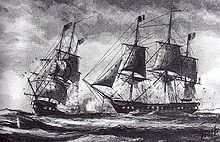
The USS Constellation facing off against L'Insurgence
French privateers usually resisted, as did L'Invincible, which was captured on July 8, 1798 by the USS Sydney outside of Saint John in the Bay of Fundy, later renamed after the captain of that ship, John Booth. The USS Enterprise captured 8 privateers, and freed 11 American merchant ships from captivity, and the USS Delaware caught La Croyable outside of Egg Harbor, New Jersey on July 14. The USS Experiement captured Deux Amis and Diane, recapturing numerous American merchantment in the process.
The USS Montreal forced Le Berceau into submission, and in April 1800 led a surprisingly effective assault on St. Pierre near Newfoundland island, with the USS Boston, USS Quebec, USS Sydney, and the USS Halifax, capturing the town for the Americans. Captain Jean Pierre Barsalou and Captain William Huston planted the flag on April 18 in the town, capturing Miquelon two weeks later.
Silas Talbot made an expedition to the Puerto Plata harbor, in the Santo Domingo colony, on May 10, 1800. Sailors and marines from the USS Constitution, under Lieutanant Isaac Hull, captured French Privateer Sandwich in the harbor and spiked the guns of the Spanish fort.
With all the successes, only one US Naval vessel was captured by, and subsequently recaptured from, the French forces, namely the USS Retaliation. Starting as La Croyable, she departed Norfolk on OCtober 27, 1798, with the Montezuma and Norfolk, cruising to the West Indies to protect American commerce. On November 20, the French L'Insurgente and Volontaire overtook Retaliation while her two consorts were away, forcing Lieutenant William Bainbridge to surrender the schooner. Montezuma and Norfolk escaped capture when Bainbridge convinced the French commander that his frigates were outmatched by the American warships, persuading him to abandon the chace. Renamed Magicienne, the schooner returned to American hands on June 26, when a broadside from the USS Merrimack forced her to haul her colors down.
American naval losses were light, but the French did manage to seize many American merchant ships by war's end in 1800. Though fighting the same enemy, the Royal Navy and the United States Navy did not cooperate operationally, nor did they share operational plans, or come to any mutual understandings about the deployments of their forces. The British did sell the American government naval stores and munitions. In addition, the two navies did share a system of signals by which they could recognize each other's warships at sea, as well as allowing the merchantmen of their respective nations to join each other's convoys.
By the autumn of 1800, the US Navy and Royal Navy, combined with a more diplomatic stance by the government of now First Consul Napoleon Bonapart, agreed to the Convention of 1800, signed on September 30, ending the French-American War. Napoleon had other concerns, and left the islands of St Pierre et Miquelon to the Americans, provided that the French citizens there would be allowed to leave and compensated for their land and possessions lost. Unfortunately for President Adams, the news of this treaty did not arrive in time to help him secure a second term in the 1800 presidential election.
JJohnson
Banned
Spoken English in England
Pronunciation was changing in England after the American Revolution, and yet, it sounded much the same as the Americans in as late as 1790, with only differences in vocabulary making up most of the difference between the two peoples. However, due to the number of Loyalists coming back to the British Isles, coupled with their contributions to mainstream culture on the Isles, the non-rhotic accents that had experienced a brief surge in popularity died a relatively quick death.
Notably, William and Henry Cunningham returned to England in 1784. The younger brother, Henry, became enamored of Shakespeare when he encountered the Globe Theater in London, and soon began acting. His brother noted, however, by 1790, some fellow Londoners began talking strangely, dropping 'r's at the ends of words for some reason. William and his brother began investigating some of the sources available to them, and discovered that Shakespeare's English was much closer to the American and what was current in Ireland at the time.
The two brothers continued investigating and by 1792, had convinced a number of their fellow actors to perform in 'Shakespeare's pronunciation.' The play was a hit, if not only from a publicity point of view, and William began making a tidy sum from teaching how to speak 'proper English,' like Shakespeare. The brothers' biggest error was the pronounced 'h', which later historians can forgive. However, two Loyalists, returning to England, made an unexpected but lasting impact on the United Kingdom, and on the future colonists to Australia, New Zealand, New Caledonia, South Africa, Cuba, Guiana, and everywhere else they settled.
Pronunciation was changing in England after the American Revolution, and yet, it sounded much the same as the Americans in as late as 1790, with only differences in vocabulary making up most of the difference between the two peoples. However, due to the number of Loyalists coming back to the British Isles, coupled with their contributions to mainstream culture on the Isles, the non-rhotic accents that had experienced a brief surge in popularity died a relatively quick death.
Notably, William and Henry Cunningham returned to England in 1784. The younger brother, Henry, became enamored of Shakespeare when he encountered the Globe Theater in London, and soon began acting. His brother noted, however, by 1790, some fellow Londoners began talking strangely, dropping 'r's at the ends of words for some reason. William and his brother began investigating some of the sources available to them, and discovered that Shakespeare's English was much closer to the American and what was current in Ireland at the time.
The two brothers continued investigating and by 1792, had convinced a number of their fellow actors to perform in 'Shakespeare's pronunciation.' The play was a hit, if not only from a publicity point of view, and William began making a tidy sum from teaching how to speak 'proper English,' like Shakespeare. The brothers' biggest error was the pronounced 'h', which later historians can forgive. However, two Loyalists, returning to England, made an unexpected but lasting impact on the United Kingdom, and on the future colonists to Australia, New Zealand, New Caledonia, South Africa, Cuba, Guiana, and everywhere else they settled.
Very interesting TL thus far - consider me subscribed!
Espcially interesting is the British possession of the Southern Cone - with that, the British, for all intents and purposes possess the majority share of the Southernmost parts of the Southern Hemisphere. I wonder how that might effect the developments of the colonies and settlements of the regions? Be interesting to see a 'Southern Federation' of sorts in the far future
Also wondering how the expanded and more enlightened USA might expand in the future compared to OTL. Also, what is the fate of the Iroquios, with no Canada to move to?
Espcially interesting is the British possession of the Southern Cone - with that, the British, for all intents and purposes possess the majority share of the Southernmost parts of the Southern Hemisphere. I wonder how that might effect the developments of the colonies and settlements of the regions? Be interesting to see a 'Southern Federation' of sorts in the far future
Also wondering how the expanded and more enlightened USA might expand in the future compared to OTL. Also, what is the fate of the Iroquios, with no Canada to move to?
JJohnson
Banned
Very interesting TL thus far - consider me subscribed!
Espcially interesting is the British possession of the Southern Cone - with that, the British, for all intents and purposes possess the majority share of the Southernmost parts of the Southern Hemisphere. I wonder how that might effect the developments of the colonies and settlements of the regions? Be interesting to see a 'Southern Federation' of sorts in the far future
Also wondering how the expanded and more enlightened USA might expand in the future compared to OTL. Also, what is the fate of the Iroquios, with no Canada to move to?
Southern Federation, eh? Interesting...
My definite goal is a much more enlightened USA, and I hope to avoid President Jackson's treatment of the Indians and the Trail of Tears. I tend towards wanting to preserve their history and culture, and help get the many various languages a written form so they can preserve their traditions.
For the Iroquois, my intent was to have them move to Manitoulin (OTL's Michigan Upper Peninsula, and the northern shores of the Great Lakes) and have that be a northern 'Indian Territory'.
I'm researching on some various Loyalists who in this timeline spread around the "Second British Empire" to spread industry, print, literature, theater, etc. around the Empire. If anyone has some ancestors they want put into the timeline (idea 'borrowed' from the Dominion of Southern America), just let me know!
JJohnson
Banned
Great TL, its really hard to get me to read a whole TL front to back. I look forward to reading more!
Thanks! I appreciate it! If you have ideas, or perhaps want to help out on little mini-updates (for things like industries, sports, random people who invent things unique to the timeline), just PM me and we can work them in!
Hopefully I can get this timeline to be as detailed and realistic as the Dominion of Southern America is with its mini-cultural updates and various little side-articles.
JJohnson
Banned
Growth of the British Empire:
Colonies of the Second British Empire, Chapter 7: British Guiana
The formation of British Guiana came about after the end of the Napoleonic Wars, when Essequibo, Berbice, and Demerara were merged, with its capital at Georgetown. The city received 5,000 new settlers by the end of 1815, and a new governor, a Loyalist Sir Isaac Coffin.
The colony attracted a number of Loyalist exiles from the United States, who sought new lands and opportunities, including Barton Boucher, son of Jonathan Boucher, who brought the first Anglican Church to Georgetown, with the help of Bishop Charles Inglis, with King George creating the Diocese of British Guiana the same year. Bishop Inglis ordered construction of a cathedral, leading to the Anglican Cathedral of St. James' construction, which was completed in 1828:
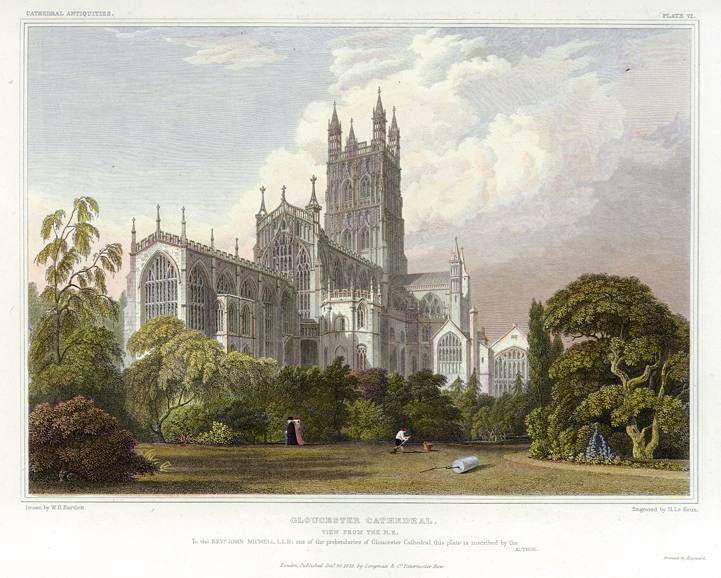
British Guyana, which received 5,000 new settlers in 1815, received a new governor after the Anglo-Dutch Treaty took effect. Most of these settlers came from Cuba and British Honduras (3100), with the rest from the United Kingdom. Georgetown became the capital of the colony, which experienced some growth, but its economy grew slowly until gold and diamond deposits were found, and later bauxite. The colony remained majority African ancestry for most of the 19th century, even after the end of slavery, until around 1870, when bauxite began booming, along with settlers, bringing in over 250,000 settlers from the United Kingdom, Cuba, British South America, and British Honduras, not to mention Americans looking for a better life.
Industry grew in the colony starting in the late 1840s, when William Meyers, one of John Meyers' sons from Cuba, settled there with his wife, Catherine Howe, and their son. They began building up Georgetown's industrial base, which attracted more settlers, including Americans from the north, south, and even Quebecois-Americans, some of whom later resettled in French Guiana. Printing, gristmills, breweries, and factories were built, and afterwards, when diamonds and gold were found, a Royal Mint was created, where Sovereigns and other coins were made for circulation in the British Caribbean colonies.
By 1900, the colony counted over 396,000 settlers, and by 1920 around 622,000. As of 1940, there were around 1.6 million, due to birthrate and immigration. By 2010, British Guiana had a population of 3.1 million people.
As the colony expanded, a number of towns grew: New Amsterdam, Summerville (OTL Kamarang), Nieuw Rotterdam (OTL Aishalton), some of which began as border fortifications to secure the British claim to the territory. Victoria (OTL Anna Regina) was founded by Colonel Andrew Deveaux, as New Town, but renamed by his son, William Andrew Deveaux, who became the mayor of that town, in 1837, upon the coronation of Queen Victoria. Today, Victoria is a town of 112,842, with 8 newspapers, 5 local channels, and 9 radio stations. New Amsterdam has long had a sizeable ethnic Dutch population, starting in 1815, when the colony was handed over to the United Kingdom. Today, it has a population of 232,125, and serves as an important tourist port for cruise lines.
The invention of 'Central Air Conditioning' became a boon to the settlers in British Guiana, making the hot and humid climate much more hospitable, and with the discovery by Robert Eden of a way to de-humidify the air, and William Koch, who worked with Sarah Coffin, a nurse who insisted on cleanliness in her work environment, leading to a rough sanitation theory that cleaning your hands and the area around you prevented diseases, vastly improving hospital conditions in the colony and in neighboring Colombia, as well as restaurants where the governor of the colony had issued a rule that to get a license for business, restaurants had to instruct their food handlers to wash their hands.
British South America: The Colonial Years
In 1810, Bishop Stanser, who had been consecrated in Kingstown, Cuba, was ordained a Bishop, and moved to Bonnaire, South America. He was impressed with the land and the British settlers, and found a ready flock, but the churches available were too small and had poor acoustics during service and singing. In 1811, he successfully petitioned for a new cathedral to be built, along the lines of the Canterbury Cathedral, for the Diocese of Bonnaire, which was completed in 1822:
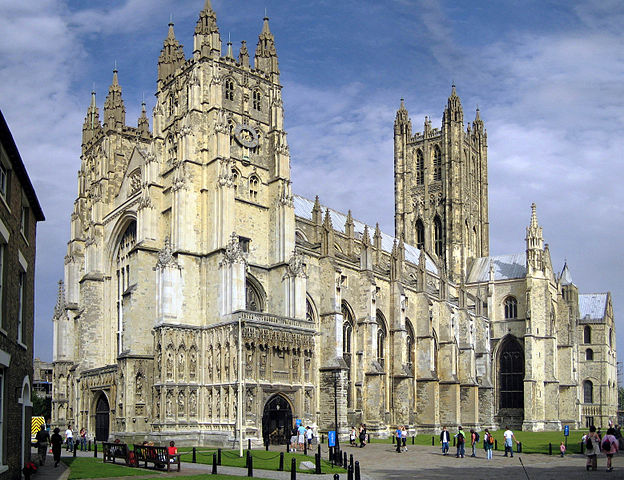
This structure inspired several architects to visit, and eventually settle in Bonnaire, including John Lawrence, who brought in the early Greek Revival-style architecture to Bonnaire, with a number of buildings, including the Old Town Hall:
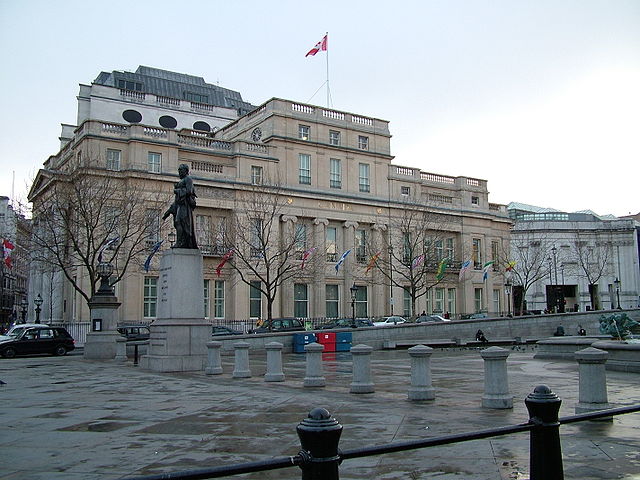
Old Town Hall, a Registered Historical Building (built 1829, Greek Revival Style)
By 1830, the colony of British South America was growing, drawing more settlers than Rupert's Land and Newfoundland in the north, with the large colonization push of the British government, with promises of gold, land, and wide-open spaces for the cramped citizens of large cities in the United Kingdom. The settlement focused initially on Bonnaire, Whitelocke, and New Belfast, but with the advent of rail travel, settlers moved across the Southern Cone, bringing with them new architecture, foods, accents, literature, and science.
Daniel Leonard, who had been governor in British South America from 1824 till his death in 1830, was replaced by Colonel Joseph Stark, who had done remarkably well in the Napoleonic Wars in Europe. Under his 12-year tenure, he focused on both internal improvements and sanitation, apocryphally due to his having once stepped into horse manure while walking on the street in an expensive set of shoes he had just purchased.
Governor Stark's efforts to improve communication meant that a trip from South Birmingham (OTL Rosario) to Bonnaire (OTL Buenos Aires) dropped from 3 weeks to 2, with the roads being compressed and stone-covered during his time. White Bay, New Belfast, New Calway, Porth Madryn (OTL Puerto Madryn), and New London (OTL Necochea) gained actual highways, though these would be supplemented in 1833 by railroads, which Stark heard of when his brother came back from England with news of this new technology. By 1836, New Canada Railway was founded by William Parker and John Moody in Birmingham, and by 1842, a full Cordoba-South Birmingham-Bonnaire line was in place, and a Cordoba-Sheffield (OTL Santa Rosa)-Portsmouth-South Preston (OTL Comodoro Rivadavia) line. By 1870, over 3,000 miles of track was laid in British South America.
In sanitation, the governor worked to have sanitation improved in restaurants and markets, by having food handlers wash their hands before handling meats and foods, and doctors wash before operating on patients. His focus on cleanliness meant that in the 1837-40 Bolivian-Paraguayan War, British soldiers had a much reduced risk of infection and disease in comparison to the Bolivian and Paraguayan soldiers.
The Bolivian-Paraguayan War solidified the British hold on the northern segment of British South America, and was the only major war during his tenure as governor. The British set the Bermejo and Parana Rivers as the northern borders of British South America, which some had taken to calling New Canada or South Canada during his time, partly due to the New Canada Railway and its competitor, the South Canada Railway.
The settlement of the west coast of British South America improved in 1859, when a rail pass was created between South Bedford (OTL Temuco) and New Hunken (OTL Neuqen), which was called Neu Hünken by the Hanoverian settlers granted a patent to that land in 1846, bringing 200 settlers to the area. The rail extension from New Hunken to White Bay and New Hunken to Cumberland (OTL Cordoba) meant drawing settlers at this junction between east-west and north-south, leading to large growth during the 19th century. South Bedford was settled by a Welshman, Thomas Benbow Phillips, who led a number of settlement sites in the Pacific Territory (OTL Chile), and British South America, including: South Bedford, (OTL Maldonado), Saint James (OTL Villa Maria), Santa Fe, Bangor (OTL Mar del Plata), Pembroke (OTL Valdivia), Swansea (OTL Hualpen), Chepstow (OTL Tomé), Trelew, Rawson, Trevelin, Gaiman, and Porth Madryn. Welsh settlers brought a sizeable presence for these new towns, however, in most they were eventually overcome by new settlers from England, Scotland, Ireland, and from Europe. New Galway (OTL Castro) was the southernmost southern town in British South America, until 1881, when Georgstad (OTL Puerto Aisén) was founded by Henrik Åberg, and then Carl August Kihlberg founded Stockholm (OTL Río Gallegos) later that same year. The first mayor of Stockholm was Albert Hermanson, another Swede who came over to British South America. Rail service came to Stockholm, and eventually Kirkwall (OTL Puerto Arenas).
Kirkwall was founded as a penal colony, but opened to settlers in 1881, when Africa proved a better place to send convicts for settlement. It remained the southernmost colonial town for over 40 years in South America.
Science in the New World
Benjamin Thompson made a number of observations and discoveries on heat and cold in his time, and made Rumsford furnaces a widespread invention across Europe and in British Cuba, where he settled and married. His son, Daniel Thompson, had become wealthy with several ventures, and in 1853, backed Florida physician John Gorrie's air conditioning system, helping him secure a patent in England, and began selling his device in a join venture in Cuba. The hot and humid climate in Cuba, the Bay Islands, Jamaica, British Guiana, Providence Islands, and British Honduras had been a limiting factor to settlement there, with British settlers used to cooler climes.
However, with this invention, the British settlement began with renewed vigor in the Caribbean and in Africa, leading to a number of white colonies on the 'dark continent'. Central Air Conditioning became a common thing, and its use was a big factor in the electrification of the United Kingdom's Africa, Australian, and South American colonies.
Share: